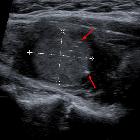triple receptor negative breast cancer
Triple receptor-negative (TRN) breast cancer or triple-negative breast cancer (TNBC) is a subtype of breast cancer characterized by a relative absence of immunohistochemical staining for the following hormone receptors/protein:
- estrogen receptor (OR)
- progesterone receptor (PR)
- human epidermal growth factor receptor 2 (HER2/neu)
Epidemiology
TRN breast cancer represents 15-20% of all breast cancers . It is more likely to affect younger people and races such as African, Americans, Hispanics, and/or those with a BRCA1 gene mutation.
Pathology
They have distinctive pathologic features, typically exhibiting a higher histologic grade, elevated mitotic count, central necrosis and fibrosis, pushing margins, scant stromal reaction, stromal lymphocytic response, and ductal or mixed histology with an overrepresentation of unusual histologies (metaplastic, medullary, or adenoid cystic carcinoma). It comprises of a heterogeneous group, encompassing at least two subcategories:
- basal subtype ~60%
- less well-defined non-basal/multiple marker negative subtype ~40%
Radiographic features
Mammography
TRN cancers were more frequently presented mammographically as a round, oval, or lobulated mass and were less frequently associated with calcifications than HER2+ / ER+ cancers. Less likely to demonstrate typical characteristics of malignancy, such as an irregular shape or spiculated margins . Associated ductal carcinoma in situ (DCIS) has also been reported at a much lower rate than HER2+, and ER+ patients.
Ultrasound
Ultrasound features of smaller TRN breast cancer (<2 cm) have generally benign characteristics with a well-circumscribed margin and posterior acoustic enhancement, which are common in benign breast masses such as fibroadenomas .
One characteristic ultrasound feature which differentiates both is the roundness of the mass. TNBC tends to be more rounded than fibroadenomas . Other associated features in TRN breast cancer rather than in fibroadenomas are:
- associated edema
- skin thickening
- suspicious axillary lymphadenopathy
Larger TRN breast cancers (>2 cm) usually show the typical malignant features on ultrasound .
MRI
- T2 with fat suppression: intratumoral hyperintensity is common corresponds to abundant cytoplasm, edematous stroma and necrosis
- T1C+: rim enhancement is a specific sign that helps to differentiate small TRN breast cancers from benign lesions like fibroadenoma
Treatment and prognosis
Due to the absence of hormone receptors and HER-2, treatments like hormone therapy and other drugs which target estrogen, progesterone and HER-2 are ineffective. However, chemotherapy is considered to be an effective option in such cases with it responding earlier and better as compared to other breast malignancies.
Triple-negative breast cancer has the worst prognosis compared to other breast cancer with a more aggressive course and higher rates of recurrence .
Siehe auch:

 Assoziationen und Differentialdiagnosen zu triple receptor negative breast cancer:
Assoziationen und Differentialdiagnosen zu triple receptor negative breast cancer:



